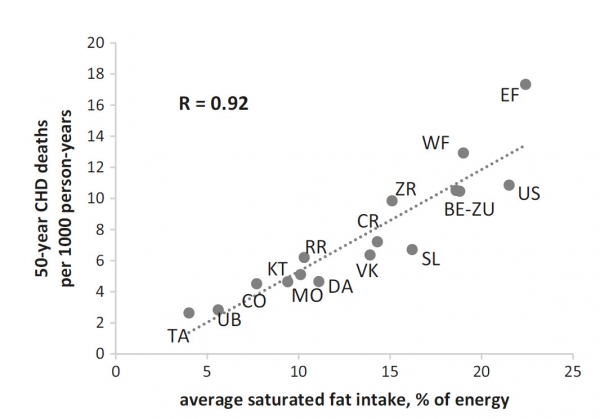Cross-cultural associations:
Average saturated fat intake and 50-year coronary heart disease mortality rates in 16 cohorts
In the 1960s there was a 6-fold difference in average population intake of saturated fatty acids: from Japan (3% of energy) to East Finland (22% of energy). The 50-year data confirm and extend the 25-year data. Average cohort intake of saturated fatty acids was strongly positively associated with 50-year CHD mortality rates (R = 0.92).
The sum of saturated and trans fatty acids was also related (R = 0.89) to 50-year CHD mortality rates. Dietary intervention studies showed that both saturated and trans fatty acids increased LDL-cholesterol, which is considered a causal risk factor of CHD.

Relationship of average population saturated fat intake at baseline and 50-year CHD death rates. BE Belgrade, Serbia, CO Corfu, Greece, CR Crevalcore, Italy, DA Dalmatia, Croatia, EF East Finland, KT Crete, Greece, MO Montegiorgio, Italy, RR Rome railroad, Italy, SL Slavonia, Croatia, TA Tanushimaru, Japan, UB Ushibuka, Japan, US US railroad, VK Velika Krsna, Serbia, WF West Finland, ZR Zrenjanin, Serbia, ZU Zutphen, the Netherlands
Interpretation
The major saturated fatty acids: lauric acid (C12:0), myristic acid (C14:0), palmitic acid (C16:0), stearic acid (C18:0) and the trans fatty acid elaidic acid (C18:1T) were strongly correlated (R >0.8) with total saturated fatty acids and their effects could not be reliably separated from each other in an ecological analysis of the 16 cohorts. Therefore, we limited the statistical analysis to the association of total saturated fatty acids with long-term CHD mortality rates. The effects of individual fatty acids can best be investigated in controlled dietary intervention studies.
